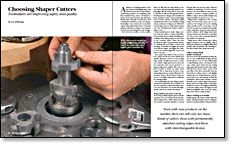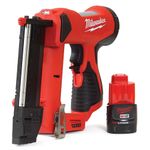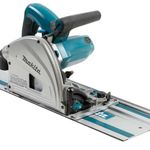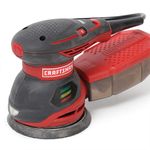Choosing Shaper Cutters
Toolmakers are improving safety and quality
Synopsis: Even with new products on the market, there are still only two basic kinds of shaper cutters: those with permanently attached cutting edges and those with interchangeable knives. Generally, the bigger and more powerful the shaper, the bigger the cutter you can use and the larger the cut you can take in one pass. In this article, Lon Schleining explains how shaper cutters work and how they are made, how to set up wing cutters, and how safety cutters help reduce kickback. He talks about how versatile insert tooling is and how to do it. And he explains how to order custom cutters. Side information tells you how to find a good toolmaker who can produce a custom profile from a drawing.
A shaper is an indispensable tool in my custom stairbuilding shop. But I had used one for 12 years before I could bring myself to try anything other than standard wing cutters. I’d heard too many stories about knives that had been thrown from old-style cutterheads to feel comfortable with them on my own shaper. Eventually, I was convinced to try modern cutters with replaceable knives—what the industry calls insert tooling. To my surprise, I found a lot had changed in cutter design.
Even with new products on the market, there are still only two basic kinds of cutters: those with permanently attached cutting edges, like the wing cutters I was used to, and those with interchangeable knives. Developments in design and manufacture have produced safer, better-performing tools of both varieties. European safety standards have led to a new family of wing cutters, and insert tooling is now offered in several styles that are a big improvement over the old-fashioned cutters, which I refuse to use.
Many manufacturers make shaper cutters, and each offers a variety of profiles. Panel-raising, flush-cutting, detailing and molding (contouring) cutters are just a few of the common styles. There are also matched sets, like cope-and-stick cutters, for making rails and stiles in doors and paneling. Generally, the bigger and more powerful the shaper, the bigger the cutter you can use and the larger the cut you can take in one pass.
Most cutters have either a 3⁄4-in. or 11⁄4-in. bore, which are the two most widely used spindle diameters, and two to four cutting edges made of high-speed steel or tungsten carbide. High-speed-steel cutters are less expensive and can be ground to a sharper edge than carbide. But I use carbide because it holds an edge much longer. This is important because every sharpening reduces a cutter’s diameter. For matched cutters, all the knives in the set must be carefully sharpened to maintain the mating profiles.
Not surprisingly, the best shaper cutters are the most expensive. But I consider cost last. The expense is only for the short-term. Over the long haul, I’ve found that highquality cutters are a better investment.
From Fine Woodworking #118
For the full article, download the PDF below:
Fine Woodworking Recommended Products

Milwaukee M12 23-Gauge Cordless Pin Nailer

Makita SP6000J1 Track Saw

Craftsman Random Orbit Sander




















Log in or create an account to post a comment.
Sign up Log in